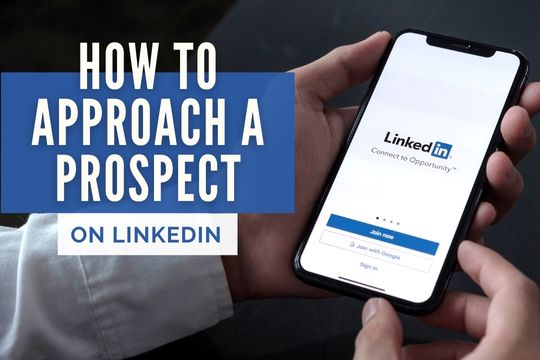
LinkedIn is the world's largest professional network, with over 500 million members in over 200 countries and territories. It's incredibly useful for finding new business and contacting B2B prospects.
It can be hard to know where to start if you're looking for prospects on LinkedIn. In this article, we'll walk through some of our favorite ways to find prospects on LinkedIn so you can get more sales and leads for your business.

You can contact prospects on LinkedIn depending on your profile and network. You should build up your profile, add blog posts, and join groups before you try to connect to any prospects. For those who need more clarification about LinkedIn as a prospecting tool, it's one of the best to. So, when should you consider updating your marketing plan to include this social network? The time is now. It's considered the tool to use for B2B lead generation.
If you don’t have any connections, start building up your connections by joining groups, connecting with your contacts, and going to networking events within your related industry. This helps you considerably when prospects view your profile and see that you have many connections and an updated profile.
The first step in marketing yourself is to determine your ideal client. This may seem obvious, but it's sometimes more clear-cut than it seems. You can start by thinking about who you've helped in the past and what they had in common. Were they all working at small businesses? Did they use Dropbox or Salesforce? Did they have a specific industry background?
If you're just starting out as an entrepreneur, there are many ways to find clients: networking events, online communities, and referrals from friends and family members (or other professionals). But even if those are areas where you've done well before—and even if those types of leads work well for others—it still helps to know which demographic categories will best suit your business's services.

Call them. Yes, it's old-fashioned, but sometimes a phone call is the best way to get someone's attention and schedule an in-person meeting (especially if you need to get more familiar with each other). If your contact gives you their direct phone number, call them directly instead of sending them a message through LinkedIn.
Send them a message on LinkedIn. If they don't have their email address publicly available on their profile or in your contact book, send them an InMail (LinkedIn's paid messaging service) asking if they'd be willing to chat about this opportunity further over the phone or in person. This will flag their inbox as important, so they'll see who sent it and respond quickly while also giving you their number if they want to keep it private via InMail.
Send them an email through your company's website or email account (if applicable). Include all relevant details about why this prospect should meet with you and why now is the right time for both parties involved; finish off by asking for five minutes of their time so that you can share more about what makes this project different from others currently being pitched around town - ideally over coffee or lunch somewhere close by where there are no distractions like phones ringing etcetera."
One of the best features of LinkedIn is the “People Also Viewed” feature. This tool shows you who has viewed your profile and lets you see who else a prospect has been looking at. That way, if you want to reach out to someone in particular or if there's someone at one of your dream companies that you want to meet, it's easier than ever before!
You can also use this feature as an extra filter when searching for people on LinkedIn. If you're searching through a specific industry or role, but don't have time to go through all the profiles yourself (or even if there are too many), try typing in keywords related to what kind of person or company you're looking for (e.g., "financial services" or "marketing manager"). If their profile comes up in the results list with other people who share those same keywords—and they've viewed yours recently—then there's a chance they'd be interested in talking with you!

Social selling is the art of using social media to connect with prospects. Social selling can be done in many ways, but you should focus on your prospects' platforms. Social selling is an important part of sales prospecting because it allows you to engage with your target audience before they’re even ready to buy—and it gives you an opportunity for real-world learning about how your potential customer uses their products or services.
Once you’ve identified your target company, the next step is to find people who mean business.
To do this, start by looking for users with titles indicating they are decision makers: CEOs, CFOs, and owners.
If you can’t find these people on LinkedIn (or if your prospective company doesn’t allow employees to list their job titles), try searching for other professionals in similar positions at other companies with similar profiles that might be interested in using your product or service.
You can also search for anyone with a title indicating they work for the target company—even if it doesn't match exactly what you're selling. This is because an employee of another department may still be able to refer you elsewhere within the organization where there's interest in using your product or service!
LinkedIn has many features that make it easy to find the right people for your business. One of the most powerful ways to search for prospects is through groups. You can easily find groups by topic, industry, or location using the search field on LinkedIn's home page. You must take time here to choose groups that will be relevant to your prospecting efforts.
Before participating or posting anything, you should look for active and well-mixed groups with many members. This will help you grow personally and professionally by engaging with others with similar interests or careers. Suppose other professionals around the world want more information about what you offer. In that case, they might be able to give their opinion on what they think would work best when talking with someone like yourself over email or even face-to-face meetings if possible!

An alumni search is a major step in any prospect research. It's a powerful LinkedIn feature lets you find people connected to your target school or company. This can be especially helpful if you're looking for prospects who work in a specific industry or live in a specific region and are likely to have some commonalities with your ideal customer profile. For example, suppose you're marketing an accounting software product targeted toward freelancers. In that case, an alumni search will help you find potential customers who graduated from the same school as one of your best salespeople (or perhaps even currently work there) but aren't currently connected to that person on LinkedIn.
Using this method requires knowing which schools and companies are relevant for the industry or vertical that's most important for your business model — so make sure you've done enough research beforehand so that when it comes time for reaching out directly via InMail message (more on this later), it'll be easier to come up with ideas about what might interest them based off their educational background rather than just going through random selection process without any real strategy behind it."
Writing a personalized message is the best way to stand out, but it can also be time-consuming if you need help with what to say.
Consider using prospect or lead message templates as a starting point, then add your own unique touch to personalize your email or InMail. This will help you get started and give you ideas for what to say.
For example, let's say that I'm reaching out to a prospect who works at Salesforce and has liked my profile:
These are good rules of thumb when you start messaging prospects on LinkedIn.
The headline is the first thing people see when they view your page, so it should be clear and concise. You can use this opportunity to introduce yourself and what you can do for them.
Don't use a generic phrase like "Hi, I'm interested in your company." Say something more specific about why you are connecting with them: "I'm interested in learning more about [their business]."
Keep the headline brief but descriptive; no one wants to read a book-length title just because there needs to be more room for an appropriate amount of information!

It can be nerve-wracking when you first start to message prospects. It's best always to personalize your messages to prospects and hone in on something you know they'll want to contact you for in the future. For example, perhaps your software has something that can fix an issue that most companies need help with in that industry.
Those whose management of time is also affected by a new LinkedIn strategy should consider working with a marketing team to improve your B2B outreach and overall strategy.
LinkedIn is an excellent way to find prospects. It's easy to use, free, and a great place to connect with people who might be interested in what you have to offer. Just remember that the best way will always be a combination of different strategies—and don't forget about your professional brand!
With more than 500 million professionals, robust search filters, and networking features like Groups and InMail, LinkedIn lets sellers pinpoint decision makers and engage them directly.
Optimize your profile first: add a clear headline, complete experience, share helpful posts, gather endorsements, and build initial connections so prospects see credibility when they view you.
Joining relevant, active Groups exposes you to concentrated audiences within your niche, lets you observe discussions, contribute expertise, and identify members who fit your ideal client profile.
Use InMail when the prospect's email or number is private; craft a concise, personalized note requesting a brief chat. If the prospect shares a direct number, call to create immediate rapport.
Personalize the greeting, mention a specific commonality or pain point, state the value you offer, keep it brief, avoid generic phrases, and end with a clear, low-commitment call to action.